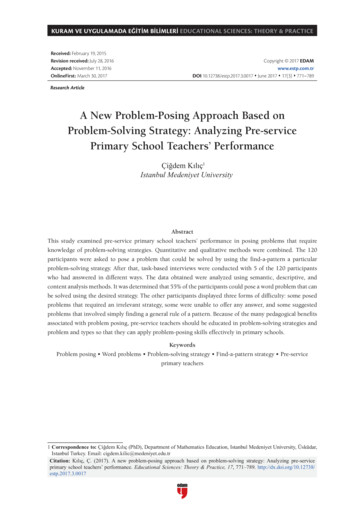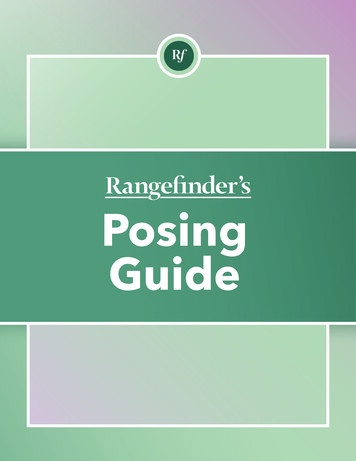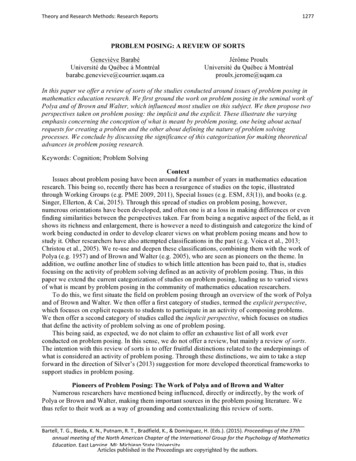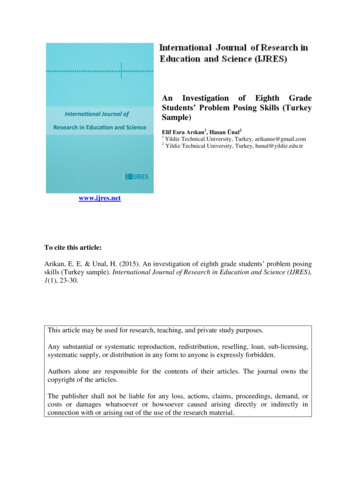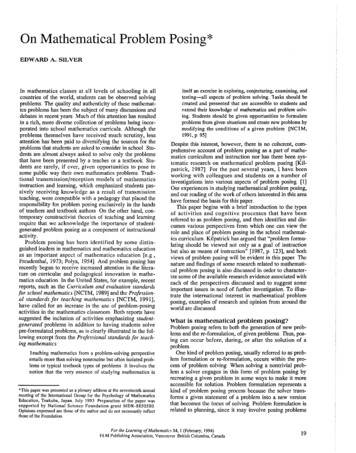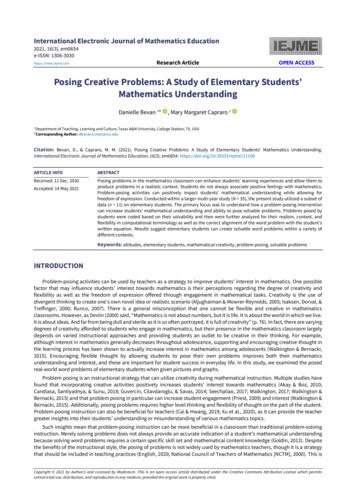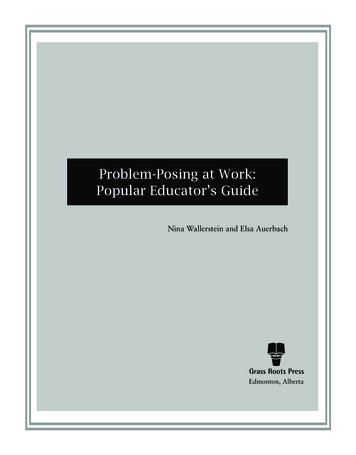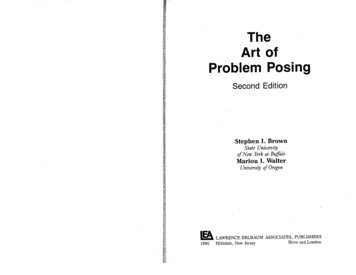
Transcription
TheArt ofProblem PosingSecond EditionStephen I. BrownState Universityof New Yorkat BuffaloMarion I. WalterUniversityof Oregon LAWRENCEERLBAUMASSOCIATES,PUBLISHERS1990Hillsdale, New JerseyHove and London
IThe Far SideIntroductionWhere do problems come from, and what do we do with them once we havethem? The impression we get in much of schooling is that they come fromtextbooks or from teachers, and that the obvious task of the student is to solvethem. Schematically, we have the following model:ProblemSolveGiven by authorityTask for studentPrimitive Think TanksTHE FAR SIDE COPYRIGHT 1988liNIYERSAL PRESS SYNDICATE.Repnnted with ,.rua.ffiti- ssion. All righ ,.,, reservea.,The purpose of this book is to encourage a shift of control from "others" tooneself in the posing of problems, and to suggest a broader conception of whatcan be done with problems as well. 1 Vihy, however, would anyone be interestedin problem posing in the first place? A partial answer is that problem posing canhelp students to see a standard topic in a new light and provide them with adeeper understanding of it as well. It can also encourage the creation of newideas derived from any ghs,n topic. Although our focus is on the field of mathe·matics, the strategies we discuss can be applied to activities as diverse as trying1We shall not provide a formal definition of "problem" here, for the issue is more complicatedthan it might appear on the surface. For an effort to define the term see Gene P. Agre ''The Conceptof Problem,'' in Educational Studies, Vol. 13. No. 2, 1982, 121-142.1
,.w.i t nVLJVt, ! I UNto create something humorous (as in The Far Side cartoon), attempting to under stand the significance of the the ory of evolution, or searching for the design of anew type of car bumper.Have you ever thought, for example, of designing car bumpers that make useof liquid or that are magnitized, or shaped like a football, or capable of inflationupon impact? Or, have you thought of the possibility that they may be made ofglass, the fragility of which might discourage people from driving recklessly orrelying so heavily on the use of the automobile?In addition to teaching explicit strategies for problem generation, there is anunderlying attitude towards "coming to know" something that we would like toencourage. Coming to know something is not a "spectator sport," though stan dard textbooks, especially in mathematics, and traditional modes of instructionmay give that impression. To say, rather, that coming to know something is aparticipant sport is to commit ourselves to a point of view requiring that weoperate on and even modify the things we are trying to understand. 2 This attitudeis central to the problem posing activities we shall develop in this book.Our strategy for presenting ideas is generally· an inductive one. Wheneverpossible, we attempt first to expose some problem posing issue through anactivity that gets at it in an implicit and playful manner. After there has beensome immersion in an activity we tum towards a reflection on its significance.We believe that it is necessary first to get "caught up in" (and sometimes even"caught" in the sense of "trapped by") the activity in order to appreciate what itis we are after. Such a point of view requires both patience and also an inclina tion to recover quickly from any embarrassment that results from being"caught. " We believe the rewards will be worth the effort.One way of gaining an appreciation for the importance of problem posing is torelate it to problem solving-a topic that has gained widespread acceptance (orrejuvenation, depending on your point of view). Problem posing is deeply em bedded in the activity of problem solving in two very different ways. First of all,it is impossible to solve any novel problem without first reconstructing the taskby posing new problem(s) in the very process of solving. Asking questions like,"What is this problem really sa)ing?" or "What if I shift my focus from whatseems to be an obvious component of this problem to a pan that seems remote?"propels us to generate new problems in an effort to "crack" th e original one.Secondly, it is frequently the case that after we have supposedly solved aproblem, we do not fully understand the significance of what we have done, unlesswe begin to generate and try to analyze a completely new set of problems. Youhave probably had the experience of solving some problem (perhaps of a practical,non-mathematical nature) only to remark, "That was very clever, but what have Ireally done?" These matters are discussed with examples in chapter 6.2See John Dewey. Reconscruction in Philosophy. Boston, Beacon Press, 1957 for an analysis ofsuch a conception of knowledge,INTRODUCTION3of.es the relationship between the askingour fonnal educanon su ppressnewaforsOftencallchwhis. In a book.and the coming up with answerments:comwinb Go :::;:n of education , D. Bo. "When I want vaur questions, I'llrowashe:.teaca, almostentlyRec :t s h: ;;:: e consists of giving definitegive them to you. · · · :u red sets in as answers are given to questions thats bo omconcrete answers. Perhapwere never asked.3robbed of the oppor·.o wev er when we arehakstatis':"oedbornthaMorems is ag of u;stions or the posing of problem eaTons.estioqugskmamadetunity ofq ally led to believe . The point isusuarewenthataskt.ficanoni·sicoreToklas, onmuch m. . de Stein's response to Alice B.of GertrU, asked,rather poignantly m the storydomwisofacylegawailll Gertrude'sce,Ah.bedthdeade'sGertruon Gertrude al·are t;e answers?"-Whereupatwhde,truGerrsweans"?"Theestions what are the. quest'ions .!egedly responded ' "Th qued up by Stephenpickisingaskor questionThe centrahty of pro e pos in; w disciplines are subdivided within then:ierst d h Toulmin in his effort t un c : sics from molecular biology , for exammat hemsnngdisatWhces.cifiencspescither p Jon to look for differencesryinand;,pie? He points out th!t ourcertainlysitotranaretscepcouic :: :s and .content is mistaken, 1or spec1;'ents . e · On the other hand Toulmm commchange over tuni'.ther . . . by their respect ve "domains/theyIf we mark sc1ences off from one ano thwhicwithctsb'even these domains have to be identi ehd n baybthuettypeems of o· '.)eny p.articular typeanse a th · · · Adeal, but rather by the questi0 s wh1c ( ) " b' chemistry , . only in so far as it is a10ot sayiof object will fall n the domamstions.4que'cal'topic for correspondingly ''biochemiin literature is' for the role of problem generationAn even deeper appreciationBeginning:theInm. Chaim Potok's novelexpressed by Mr. Lune to his son,:iin peace once said torest.you something my brother D.av , d , may he tlonI want to tell. . . .t ques s as 1't is tile important1mportanme. He said 1t ts as 1mpo.rtant to learn the the questions to which there may not beearn1tontortaimpiallyespecanswers. It i,:;good answers. 5e questions may not have good answ:\lndeed we need to find out why somatm fooli or : ::} s 0 iFor exam;le, the que stions might see:ia:;ht:: :ques onsthe questions are fundamental human.Press, 1981 , p. 127.· Cornell University. eton n· st-1"'D Bob Gowin,, Educanng, Ithaca, NY·' N P- , 19i7 p · 149.1., roverPrincton:Prince4Stephen Toolrnm, Human. U derstand;.nyg.ork. K.:nopf Publishers , 19761 pp. 295-296.SChalm Potok. In the Beg:nnmg. New
INTRODUCTIONlifetime to try to understand; it may be that they are unanswerable questionsbecause they are undecidable; it might also be, however, that our perspective ona problem is too rigid and we are blinded in our ability to see how a questionmight bear on a situation.The history of every discipline-including mathematics-lends credence tothe belief not only that it may be hard to distinguish good questions from badones in some absolute sense, but that very talented people may not be capable ofseeing the difference even for a period of centuries. For a very long time, peopletried to prove Euclid's fifth postulate:0There is another reason for asking interesting questions about a situationbesides wanting to engage in creative activity or searching for answers: In look-ing at what happens when we pose new questions concerning an object-like asugar cube or a statement that a number has exactly three different factors-webegin to "see" the object as we had never seen it before. We gain a deeperunderstanding of what constitutes a sugar cube or what it means for a number tobe divisible by three factors. We shall further discuss issues of meaning andsignificance in chapter 3.Sometimes the questions we ask about a phenomenon or a situation keep ourperceptions of it intact. Sometimes, however, we end up drastically revisingThrougha given externalpoint, there is exactly one line parallelto a giVenline.It was only during the past century that we began to realize that the difficultyin answering the question lay in the assumptions behind the question itself. Theimplicit question was:How can you prove the parallel postulate from the other postulates or axioms?It took hundred's of years to appreciate that the "how" was an unrecognizedmonster. If you delete the "how," the question is answerable (in the negative itturns out); if you do not do so, the question destroys itself as is the case with thequestion, "When did you stop beating your spouse"?So far, we have tried to point out some intimate connections between theasking and answering of questions, and between the posing and solving ofproblems. There is a sense, however, in which problem generation is an important activity to pursue, even in the absence of uncovering "the right" solution,question or questions. In fact, there are many situations for which the concept ofa right question is inappropriate. Imagine being given a situation in which noproblem has been posed at all. A reasonable task might be to generate a problemor to ask a question, not for the purpose of solving the original situation (alinguistically peculiar formulation), but in order to create a problem that derivesfrom the situation.Suppose, for example, that you are given a sugar cube or the statement, "Anumber has exactly three factors." Strictly speaking, there is no problem ineither case. Yet there is an infinite number of questions we can ask about eitherof the situations-some more meaningful than others, some more significantthan others. However, it is rarely possible to tell in the absence of considerablereflection what questions or problems are meaningful or significant. We hope topersuade you in much of what follows, that things like significance and meaningfulness are as much a function of the ingenuity and the playfulness we bring toa situation as they are a function of the questions we ask. Frequently, even aslight tum of phrase will transform a situation that appears dull into one that"glitters."what we start with in the modifications we make. It is ironic that we sometimescome to "see" what is staring us in the face only after we "destroy" it in someway-at least mentally. The strategies behind such radical reconstruction of anobject are discussed in chapters 4 and 5.It is no great secret that many people have a considerable fear of mathematicsor at least a wish to establish a healthy distance from it. There are many reasonsfor this attitude, some of which derive from an education which focuses on"right" answers. People tend to view a situation or even a problem as somethingthat is given and that must be responded to in a small number of ways. Frequentlypeople fear that they will be stuck or will not be able to come up with what theyperceive to be the right way of doing things.Problem posing, however, can create a totally new orientation towards theissue of who is in charge and what has to be learned. Given a situation in whichone is asked to generate problems or ask questions-in which it is even pennissible to modify the original thing-there is no right question to ask at all.Instead, there are an infinite number of questions and/ or modifications and, aswe implied earlier, even they cannot easily be ranked in an a priori way.Thus we can break the "right way" syndrome by engaging in problem generation. In addition, we may very well have the beginnings of a mechanism forconfronting the rather widespread feelings of mathematical anxiety.This book then represents an effort on our part to try to understand:I. What problem posing consists of and why it is important.2. What strategies exist for engaging in and improving problem posing.3. How problem posing relates to problem solving.While problem posing is a necessary ingredient of problem solving, it takesyears for an individual-and perhaps centuries for the species-to gain thewisdom and courage to do both of these well. No single book can provide apanacea for improving problem posing and problem solving. However this bookoffers a first step for those who would like to learn to enhance their inclination topose problems. While this book does touch upon problem solving, it does soprimarily as it relates to problem posing.
61.ORIGINS OF THE BOOKINTRODUCTIONAUDIENCEThe Art of Problem Posing is written for a wide audience. It is intended forcollege math students, interested laypersons, present and future teachers of mathematics in middle school, in secondary school, and in higher levels of education.It also has implications for curriculum writers and for those who wish to doresearch on the power of problem posing and its relationship to a host of variables ranging from fear of mathematics to new strategies for teaching mathematics. We hope that it suggests directions for educators in fields other thanmathematics as well. In fact, we are eager to continue to hear from practitionersin fields such as architecture, medicine, and engineering, who have viewed theirwork from a problem posing point of view, and who might find it useful to applysome of our techniques. 6Much of the book can be appreciated after having completed a high schoolmathematics program, although we occasionally assume a mathematics background roughly comparable to what is learned through the junior year in college.Because we hope to appeal to a wide audience, we have intentionally selecteda variety of mathematical topics and types of exposition to develop our points.We hope that people without extensive mathematical background will not be putoff by what may occasionally appear to be technical approaches. On the otherhand, we hope that people with a strong math background will appreciate the factthat material which appears simple may have considerable depth, and that much· of what we discuss has implications for the most advanced mathematicalmaterial.WAYS OF READINGTHE BOOKWhile it would be helpful to explore many of the specific mathematical ideaspresented in each chapter before attempting to follow the more general issues webring up, it will not be a hindrance to skip a few examples during the firstreading, should they seem too difficult.We have stressed the importance of participation in coming to know and wehope that you will read this book in an active way. So, throughout the book, weask a number of questions which we hope you will pursue. In fact, quite frequently, what we are after is a set of questions on your part and not primarily aset of answers to our questions.Chapters 2 through 6 deal primarily with matters of problem generation and6See Donald A. SchOn's The Reflective Practitioner, New York, Basic Books, 1983 andEducating TheReflective Practitioner, SanFrancisco,Jossey-Bass,1987 for a discussionof the needto re-conceprualizethe preparationof professionalsin all fields so as to view problem posing as acentralphenomenon. His discussion of the trainingof architectsin particularis quite enlightening.7should be of interest to the mathematics student and the layperson. Chapter 7creates a pedagogical setting for an application of the point of view developedearlier. There we explore the concept of using an editorial board and suggestmethods of incorporating it in the classroom in order to implement some of ourproblem posing strategies. This approach might be of interest to educators at alllevels who would like to investigate a novel scheme for placing the student in amore active role. Especially given the emerging concept of writing across thedisciplines (and not just in fields such as history and English), educators in allfields might wish to adapt parts of this approach in their own field of expertise.ORIGINSOF THE BOOKThe material for this book has grown out of our experience in creating and teamteaching courses on problem posing and solving at Harvard Graduate School ofEducation over two decades ago. 7 In addition to graduate students whose majorconcern was mathematics and education on both the elementary and secondaryschool level, on several occasions we had students at Harvard take our coursewho were preparing to be lawyers, anthropologists, and historians. Subsequently, we have taught variations of that course to both graduate and undergraduate students at numerous institutions, including Syracuse University,Dalhousie University, the University of Georgia, the University of Oregon, theUniversity at Buffalo, and Hebrew University in Jerusalem. It is interesting forus to reflect on the fact that we did not originally perceive that we were creatingsomething of a paradigm shift in focusing on problem posing. We thought ratherthat we were adding a new and rather small wrinkle to the already existing bodyof literature on teaching of problem solving that had been popularized primarily7Inadditionto teachingcourseson problemposing andsolving we have publisheda numberofarticles dealing either directly or indirectlywith several themes of this book. Some of the chaptersreflect or incorporatematerialfrom these articles. The following co-authoredpieces deal directlywith the theme of problem posing: "What-If-Not," Mathematics Teaching (British Journal), 46,Spring 1969, p. 38-45; "What-If-Not? An Elaboration and Second illustration," MathematicsTeaching, 51, Spring 1970, p. 9-17; ''Missing Ingredientsin Teacher Training:One Remedy,''AmericanMathematicalMonthly, April 1971, p. 399-404; ''The Roles of the Specific and GeneralCases in ProblemPosing," 59, Mathematics Teaching, p. 52-54; "ProblemPosing and Solving:AnIllustrationof Their Interdependence,''Mathematics Teacher, 70, 1, Fall 1977, p: 4-13.Modificationsof the firsttwo pieces appearas partof chapter4; a few sections of the thirdappearin Chapter7; a small partof the fourthappearsin chapter3; a modified version of the last in chapter6. The editorsof each of thejournalswithinwhich the materialoriginallywas publishedhave grantedpermissionto use what appearsherein.In additionto articlesdealing with problemgenerationexplicitly, we have each madeimplicituseof problemgenerationin several others.These pieces are mentionedin chapter5 in the contextof thedevelopmentof relevantideas.
,e work of George Polyil. Over time, however, we have come to see that the ity of problem posing is capable of assuming a kind of centrality in its ownt. Actually, it was the question we ask the reader to consider at the beginninghapter 2 (about the Pythagorean equation) which launched us on the venturehe first place.The emergence of a new interdisciplinary journal in 1987 entitled "Question; Exchange" (edited by James T. Dillon from the University of California atverside) signals that the primacy of the problem or the question over the,lution or the answer has begun to be appreciated in all fields of scholarship. 8Before embarking on our actual exploration of problem posing, we should1ention that there will be a modicum of repetition of key ideas throughout theext. There are several reasons for iliis. First, and most importantly, these.ideasrre novel ones and it will most likely take a while to appreciate their force.Secondly (as we recommended in the previous section), you probably will skimthe book at first and will not come across repetition until a second or thirdreading. Thirdly, we are now 110 years old (between the two ofus) and we havebecome ever so slightly forgetful over the past few years. Fifthly, and mostimportantly, these ideas are novel ones and it will most likely take a while toappreciate their force!What problems can you pose starting with the number 11O?2Two Problem PosingPerspectives: Accepting andChallengingA FIRST LOOK; WHAT ARE SOME ANSWERS?x2 y2 22After looking at the above equation, respond to the following:Hv\i11atare some answers?"We have asked this question of our students and colleagues over the years.Before reading on, you might wish to answer it yourself. Jot down a fewresponses on a piece of paper, and we will then discuss the significance of theabove question.First Question RevisitedWhat was your reply to the question which opened this chapter? Answers willdepend in part on your level of mathematical experience. People who have hadvery little experience with mailiematics frequently respond, "Oh, that remindsme of some statement about right triangles, but I can't remember it exactly."Those who have had more experience with mathematics sometimes respondwith a list like the following:SThoughan importantandambitiousundertaking,thejournalwas unfortunatelyshort·Hved.Thelast issue was publishedtwo years afterthe first.3, 4, 55, 12, 138, 15, 17.0
102.A FIRST LOOK; WHAT ARE SOME ANSWERS?1WO PROBLEM POSING PERSPECTIVES"Let's find the sum by adding from left to right but carryingin the wayThen they remark that they know there are a few other such number triples butthey cannot recall them.Among those who have had a great deal of experience, we have frequentlyreceived the above aud, in addition, a comment about the potential length of sucha list. They suggest how mauy triples there are and, occasionally, either recall orattempt to generate a formula for them.People who know more about real or imaginary numbers are often pleasedwhen, almost in a sense of amusement, they produce the following sets ofnumbers:2, 3,v'l3or i, I, 0.Now look back at all the above responses. Notice that something very significant has happened. All the responses to, "What are some answers?" assume thata question has been asked by the equation itself. Furthermore, they assume thatthe specific question asked when we wrote "x 2 y2 z2" was: "What aresome integer solutions (or perhaps real or imaginary ones)?"Notice, however, that "x 2 y2 z2 " is not in itself a question at all. Ifanything, it begs for you to ask a question or to pose a problem rather than toanswer a question.It may look as if we are splitting hairs or that we have pulled your leg bysetting a trap. Our experience indicates, on the contrary, that we are getting atsomething important. Perceiving x2 y2 z2 only as an equation that requiressolving for x, y, and z reveals a very limited perspective. As you read on, youwill see that the issues we are getting at open up vast new possibilities forlearning in general and for learning mathematics in particular.There is a myth that it is the role of the expert or authority (textbook, teacher,research mathematician) to ask the questions aud for the smdent merely toanswer them. Of course, it is considered good pedagogy to encourage smdents toask questions, but they are usually questions of au instrumental namre-questions that enable teachers to pursue their pre-conceived agendas.Frequently smdents are encouraged to ask questions which enable them tobetter follow well-trodden terrain that has been laid out not only by their teacher,but by the mathematics community at large. In grade school, for example,teachers encourage children to ask questions to make sure that they understandexisting procedures.A typical interchange might be:I showed you.9 5 8,77TI"You see, you get the answer 713, but you know it must be wrongbecause you can tell the answer mustbe less than200.''Note that the teacher has not approached the question in a completely arbitraryway, for a reason has been offered other than the teacher's authority for preferring one method over another. Furthermore, it is possible that Johnny's questioncould lead to some interesting exploration. For example, a teacher could encourage a smdent to investigate modified strategies for which we could get the correctanswer by adding from left to right. Or the teacher aud smdent could explore theextent to which the notation itself imposes one algorithm over another. Nonetheless, smdents and teachers do not usually ask questions for such purposes; rather,they are interestedin making sure that their studentsunderstandand can executewhat is expected of them.Such au atmosphere neither leads to understanding the significance of anactivity or a procedure, nor does it contribute to the development of a sense ofautonomy and independence. In contrast, problem posing cau give one a chanceto develop independent thinking processes. Most people have been denied thisingredient in their learning-especially in their mathematics classes. It is theability to pose problems rather than merely to ask procedural questions, such asthe one above, that is a central component in the development of an autonomousperson.A SECONDLOOK AT x2 y2 z2Reconsider x2 y2 z2 . Now let us ask not, "What are some answers?" but,"What are some questions?" Before reading on, list some of your ownquestions.Here are some of the responses people have given at this early· stage:Teacher: "Do you understandhow to add two-digit numbers?"Johnny: "Did you say we have to add from right to left?"Teacher: "Good question. Yes. Let me show you what happens if you did itfrom left to right. Let's do a problem. ·95 8711I.2.3.4.Who first discovered it?Are the solutions always integers?How do you prove it?What's the geometric significance of this?
122. TWO PROBLEM POSING PERSPECTIVESA FIRST LOOK; WHAT ARE SOME ANSWERS?13Loosening UpIn order to loosen up your own thinking processes further at this point and to givethem free reign, write down any ideas, not necessarily questions, that occur toyou when you look at and think about x2 y2 z2 . No holds barred! We areasking you to free associate and write down any ideas you have.Some Typical ObservationsDid you write down any statements or questions of the following types?I. Some famous right triangles are 3, 4, 5; 5, 12, 13; and 8, 15, 17.547. How do you find more triplets satisfying x2 y2 z2?8. ls 3, 4, 5 considered different from 6, 8, 10 or from 30, 40, 50?9. It has to do with squares on the sides of a right triangle.32. The Greeks used knots on a rope to make a right triangle.3.4.5.6.You can use it to introduceirrationalnumbers.This is associated with the Pythagorean Theorem.It's the only thing I remember from geometry.It reminds me of ladders against a wall.10. What good is any of this?Notice that even in this small sample of observations, we have a few newideas for x2 y2 z2: Namely, that it can deal with triangles; that it has ahistory; and that there are applications of it.
142.TWO PROBLEM POSING PERSPECTIVESA NEW PERSPECTIVEA NEW PERSPECTIVEWe are not yet done with the equation x2 y2 z2. In fact, we have hardlybegun. Compare the kinds of questions just mentioned with the following list ofquestions also using x2 y 2 z2 as a point of departure:l. For what integral values of x, y, z.is it true that x2 y 2 z2?2. For what values is it true that x2 y2 1 z2?3. What happens to the Pythagorean Theorem if the triangle is not a righttriangle? That is, suppose the right angle is replaced by a 60' angle. Howis x2 y2 z2 affected?4. For what 60' triangles (i.e., triangles with at least one 60' angle) can youfind three sides that are all integers?If you replace the squares on each side of the triangle by rectangles that arenot squares, do the areas on the legs ever add up to the area of therectangle on the hypotenuse?(6) Is there a three-dimensional analogue for the Pythagorean Theorem?'-"7. What analogy is there for four-sided figures? A Reflection on the Preceding QuestionsWhat are the differences between the thinking shown in the preceding set ofquestions and the thinking shown in questions and observations we made in theprevious subsections?There are many ways of answering this question. In making such comparisonswhat we see is very much a function of our idiosyncratic experiences and of thekinds of lenses we are accustomed to use. We could, for example, try to comparethe questions with regard to their degree of generality or the sense in which theycall for algorithms. Since you do not know where we are headed at this point, itis probably very difficult to get a grasp on what we see as a salient differencebetween the above seven questions and those that precede them. Nevertheless weurge you to take a stab. Compare the section "Some Typical Observations" withthe section "A New Perspective" and see if you can find some differences thatmean something to you.Perhaps you have observed differences of the following kinds:l. Degree to which you strive only for solutionsx2 yz z2.of the equation2. Degree to which you search for literal or narrow interpretation of theequation x2 y2 z2.3. The degree to which you risk asking questions for which you may not havea method of solution.154. The style in which you interpret the mathematics, for example, geometrically or algebraically.In addition to these four categories (and many others), there is one that hassignificantly influenced our thinking about problem posing. It is a bit subtle andtook us a while to appreciate, although after realizing it, it is hard to imagine thatthere was a time we did not see it.5. The degree to which one "accepts" the given.Notice that sometimes we have essentially accepted the given-in this casexz y2 z 2 and its relationship to the Pythagorean Theorem-and sometimeswe have challenged the given in order to ask new questions. We do not, in thelatter case, take the given for granted. Rather, the giv
oneself in the posing of problems, and to suggest a broader conception of what can be done with problems as well. 1 Vihy, however, would anyone be interested in problem posing in the first place? A partial answer is that problem posing can help students to see a standard topic in a new light and provide them with a deeper understanding of it as .


